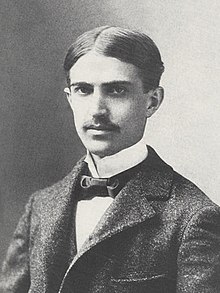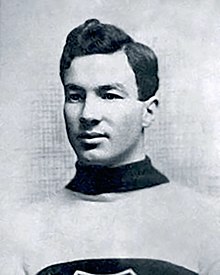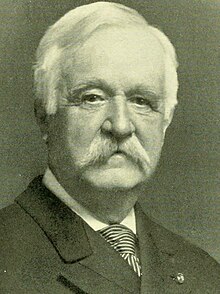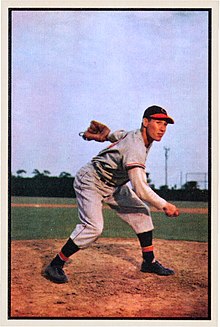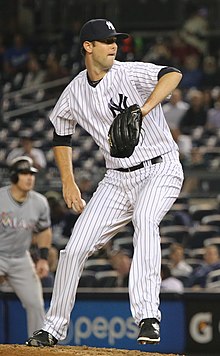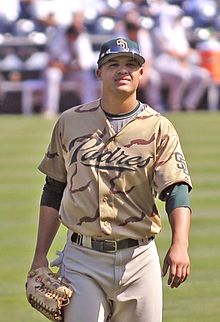Portal:Baseball
Portal maintenance status: (June 2018)
|
| Main page | Content, Categories & Topics | WikiProjects & Things you can do |
The Baseball Portal
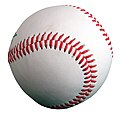
Baseball is a bat-and-ball sport played between two teams of nine players each, taking turns batting and fielding. The game occurs over the course of several plays, with each play generally beginning when a player on the fielding team, called the pitcher, throws a ball that a player on the batting team, called the batter, tries to hit with a bat. The objective of the offensive team (batting team) is to hit the ball into the field of play, away from the other team's players, allowing its players to run the bases, having them advance counter-clockwise around four bases to score what are called "runs". The objective of the defensive team (referred to as the fielding team) is to prevent batters from becoming runners, and to prevent runners advancing around the bases. A run is scored when a runner legally advances around the bases in order and touches home plate (the place where the player started as a batter).
The opposing teams switch back and forth between batting and fielding; the batting team's turn to bat is over once the fielding team records three outs. One turn batting for each team constitutes an inning. A game is usually composed of nine innings, and the team with the greater number of runs at the end of the game wins. Most games end after the ninth inning, but if scores are tied at that point, extra innings are usually played. Baseball has no game clock, though some competitions feature pace-of-play regulations such as the pitch clock to shorten game time.
Baseball evolved from older bat-and-ball games already being played in England by the mid-18th century. This game was brought by immigrants to North America, where the modern version developed. Baseball's American origins, as well as its reputation as a source of escapism during troubled points in American history such as the American Civil War and the Great Depression, have led the sport to receive the moniker of "America's Pastime"; since the late 19th century, it has been unofficially recognized as the national sport of the United States, though in modern times is considered less popular than other sports, such as American football. In addition to North America, baseball spread throughout the rest of the Americas and the Asia–Pacific in the 19th and 20th centuries, and is now considered the most popular sport in parts of Central and South America, the Caribbean, and East Asia, particularly in Japan, South Korea, and Taiwan. (Full article...)
 Featured articles - load new batch
Featured articles - load new batch
-
Image 1

Depiction of the game from The Boston Globe
On Saturday, May 1, 1920, the Brooklyn Dodgers and the Boston Braves played to a 1–1 tie in 26 innings, the most innings ever played in a single game in the history of Major League Baseball (MLB). The game was played at Braves Field in Boston before a crowd estimated at 4,000. Both Leon Cadore of Brooklyn and Joe Oeschger of Boston pitched complete games, and with 26 innings pitched, jointly hold the record for the longest pitching appearance in MLB history. Their record is considered unbreakable, as modern pitchers rarely pitch even nine innings, and newer baseball rules have made long extra-innings games a rarity.
The day of the game saw rainy weather, and it was uncertain if the game would be played, but the skies cleared enough to allow it to proceed. Brooklyn scored a run in the fifth inning, and Boston in the sixth; thereafter, the pitchers became increasingly dominant. As the game exceeded eighteen innings, the small crowd at Braves Field cheered both pitchers. The last twenty innings were scoreless, and when darkness started to fall, the umpires called a halt after the twenty-sixth inning, as baseball fields did not yet have artificial lighting. (Full article...) -
Image 2
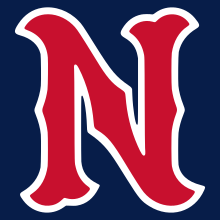
The Nashville Sounds are a Minor League Baseball team of the International League and the Triple-A affiliate of the Milwaukee Brewers. They are located in Nashville, Tennessee, and are named for the city's association with the music industry, specifically the "Nashville sound", a subgenre of country music which originated in the city in the mid-1950s. The team plays their home games at First Horizon Park, which opened in 2015 on the site of the historic Sulphur Dell ballpark. The Sounds previously played at Herschel Greer Stadium from its opening in 1978 until the end of the 2014 season. They are the oldest active professional sports franchise in Nashville.
Established as an expansion team of the Double-A Southern League in 1978, the Sounds led all of Minor League Baseball in attendance in their inaugural season and continued to draw the Southern League's largest crowds in each of their seven years as members. On the field, the team won six consecutive second-half division titles from 1979 to 1984 and won the Southern League championship twice: in 1979 as the Double-A affiliate of the Cincinnati Reds and again in 1982 as the Double-A affiliate of the New York Yankees. (Full article...) -
Image 3

Ian Michael Chappell (born 26 September 1943) is a former cricketer who played for South Australia and Australia. Known as "Chappelli", he is considered as one of the greatest captains the game has seen. He captained Australia between 1971 and 1975 before taking a central role in the breakaway World Series Cricket organisation. Born into a cricketing family—his grandfather and brother also captained Australia—Chappell made a hesitant start to international cricket playing as a right-hand middle-order batsman and spin bowler. He found his niche when promoted to bat at number three. Chappell's blunt verbal manner led to a series of confrontations with opposition players and cricket administrators; the issue of sledging first arose during his tenure as captain, and he was a driving force behind the professionalisation of Australian cricket in the 1970s. He was the captain of the Australian squad which finished as runners-up at the 1975 Cricket World Cup.
John Arlott called him "a cricketer of effect rather than the graces". An animated presence at the batting crease, he constantly adjusted his equipment and clothing, and restlessly tapped his bat on the ground as the bowler ran in. Basing his game on a sound defence learned during many hours of childhood lessons, Chappell employed the drive and square cut to full effect. He had an idiosyncratic method of playing back and across to a ball of full length and driving wide of mid-on, but his trademark shot was the hook, saying "three bouncers an over should be worth 12 runs to me". A specialist slip fielder, he was the fourth player to take one hundred Test catches. (Full article...) -
Image 4
George Herman "Babe" Ruth (February 6, 1895 – August 16, 1948) was an American professional baseball player whose career in Major League Baseball (MLB) spanned 22 seasons, from 1914 through 1935. Nicknamed "the Bambino" and "the Sultan of Swat", he began his MLB career as a star left-handed pitcher for the Boston Red Sox, but achieved his greatest fame as a slugging outfielder for the New York Yankees. Ruth is regarded as one of the greatest sports heroes in American culture and is considered by many to be the greatest baseball player of all time. In 1936, Ruth was elected to the Baseball Hall of Fame as one of its "first five" inaugural members.
At age seven, Ruth was sent to St. Mary's Industrial School for Boys, a reformatory where he was mentored by Brother Matthias Boutlier of the Xaverian Brothers, the school's disciplinarian and a capable baseball player. In 1914, Ruth was signed to play Minor League baseball for the Baltimore Orioles but was soon sold to the Red Sox. By 1916, he had built a reputation as an outstanding pitcher who sometimes hit long home runs, a feat unusual for any player in the dead-ball era. Although Ruth twice won 23 games in a season as a pitcher and was a member of three World Series championship teams with the Red Sox, he wanted to play every day and was allowed to convert to an outfielder. With regular playing time, he broke the MLB single-season home run record in 1919 with 29. (Full article...) -
Image 5Los Angeles Angels center fielder Mike Trout hits a home run on a pitch from New York Mets pitcher Tommy Milone on May 21, 2017.
Baseball is a bat-and-ball sport played between two teams of nine players each, taking turns batting and fielding. The game occurs over the course of several plays, with each play generally beginning when a player on the fielding team, called the pitcher, throws a ball that a player on the batting team, called the batter, tries to hit with a bat. The objective of the offensive team (batting team) is to hit the ball into the field of play, away from the other team's players, allowing its players to run the bases, having them advance counter-clockwise around four bases to score what are called "runs". The objective of the defensive team (referred to as the fielding team) is to prevent batters from becoming runners, and to prevent runners advancing around the bases. A run is scored when a runner legally advances around the bases in order and touches home plate (the place where the player started as a batter).
The initial objective of the batting team is to have a player reach first base safely; this generally occurs either when the batter hits the ball and reaches first base before an opponent retrieves the ball and touches the base, or when the pitcher persists in throwing the ball out of the batter's reach. Players on the batting team who reach first base without being called "out" can attempt to advance to subsequent bases as a runner, either immediately or during teammates' turns batting. The fielding team tries to prevent runs by using the ball to get batters or runners "out", which forces them out of the field of play. The pitcher can get the batter out by throwing three pitches which result in strikes, while fielders can get the batter out by catching a batted ball before it touches the ground, and can get a runner out by tagging them with the ball while the runner is not touching a base. (Full article...) -
Image 6Disco Demolition Night was a Major League Baseball (MLB) promotion on Thursday, July 12, 1979, at Comiskey Park in Chicago, Illinois, that ended in a riot. At the climax of the event, a crate filled with disco records was blown up on the field between games of the twi-night doubleheader between the Chicago White Sox and the Detroit Tigers. Many had come to see the explosion rather than the games and rushed onto the field after the detonation. The playing field was so damaged by the explosion and by the rioters that the White Sox were required to forfeit the second game to the Tigers.
In the late 1970s, dance-oriented disco was the most popular music genre in the United States, particularly after being featured in hit films such as Saturday Night Fever (1977). However, disco sparked a major backlash from rock music fans—an opposition prominent enough that the White Sox, seeking to fill seats at Comiskey Park during a lackluster season, engaged Chicago shock jock and anti-disco campaigner Steve Dahl for the promotion at the July 12 doubleheader. Dahl's sponsoring radio station was WLUP (97.9 FM, now WCKL), so admission was discounted to 98 cents for attendees who turned in a disco record; between games, Dahl was to destroy the collected vinyl in an explosion. (Full article...) -
Image 7
Stephen Crane (November 1, 1871 – June 5, 1900) was an American poet, novelist, and short story writer. Prolific throughout his short life, he wrote notable works in the Realist tradition as well as early examples of American Naturalism and Impressionism. He is recognized by modern critics as one of the most innovative writers of his generation.
The ninth surviving child of Methodist parents, Crane began writing at the age of four and had several articles published by 16. Having little interest in university studies though he was active in a fraternity, he left Syracuse University in 1891 to work as a reporter and writer. Crane's first novel was the 1893 Bowery tale Maggie: A Girl of the Streets, generally considered by critics to be the first work of American literary Naturalism. He won international acclaim for his Civil War novel The Red Badge of Courage (1895), considered a masterpiece by critics and writers. (Full article...) -
Image 8Ross with the Montreal Wanderers, circa 1907–18
Arthur Howey Ross (January 13, 1885 – August 5, 1964) was a Canadian professional ice hockey player and executive from 1905 until 1954. Regarded as one of the best defenders of his era by his peers, he was one of the first to skate with the puck up the ice rather than pass it to a forward. He was on Stanley Cup championship teams twice in a playing career that lasted thirteen seasons; in January 1907 with the Kenora Thistles and 1908 with the Montreal Wanderers. Like other players of the time, Ross played for several different teams and leagues, and is noted for his time with the Wanderers while they were members of the National Hockey Association (NHA) and its successor, the National Hockey League (NHL). In 1911, he led one of the first organized player strikes over increased pay. When the Wanderers' home arena burned down in January 1918, the team ceased operations and Ross retired as a player.
After several years as an on-ice official, he was named head coach of the Hamilton Tigers for one season. When the Boston Bruins were formed in 1924, Ross was hired as the first coach and general manager of the team. He later coached the team on three separate occasions until 1945, and stayed as general manager until his retirement in 1954. Ross helped the Bruins finish first place in the league ten times and win the Stanley Cup three times; Ross personally coached the team to two of those victories. After being hired by the Bruins, Ross, along with his wife and two sons, moved to a suburb of Boston, and he became an American citizen in 1938. He died near Boston in 1964. (Full article...) -
Image 9
Morris Berg (March 2, 1902 – May 29, 1972) was an American professional baseball catcher and coach in Major League Baseball who later served as a spy for the Office of Strategic Services during World War II. He played 15 seasons in the major leagues, almost entirely for four American League teams, though he was never more than an average player and was better known for being "the brainiest guy in baseball." Casey Stengel once described Berg as "the strangest man ever to play baseball."
Berg was a graduate of Princeton University and Columbia Law School, spoke several languages, and regularly read ten newspapers a day. His reputation as an intellectual was fueled by his successful appearances as a contestant on the radio quiz show Information Please, in which he answered questions about the etymology of words and names from Greek and Latin, historical events in Europe and the Far East, and ongoing international conferences. (Full article...) -
Image 10
James Francis Thorpe (Meskwaki: Wa-Tho-Huk, translated as "Bright Path"; May 22 or 28, 1887 – March 28, 1953) was an American athlete and Olympic gold medalist. A member of the Sac and Fox Nation, Thorpe was the first Native American to win a gold medal for the United States in the Olympics. Considered one of the most versatile athletes of modern sports, he won two Olympic gold medals in the 1912 Summer Olympics (one in classic pentathlon and the other in decathlon). He also played football (collegiate and professional), professional baseball, and professional basketball.
He lost his Olympic titles after it was found he had been paid for playing two seasons of semi-professional baseball before competing in the Olympics, thus violating the contemporary amateurism rules. In 1983, 30 years after his death, the International Olympic Committee (IOC) restored his Olympic medals with replicas, after ruling that the decision to strip him of his medals fell outside of the required 30 days. Official IOC records still listed Thorpe as co-champion in decathlon and pentathlon until 2022, when it was decided to restore him as the sole champion in both events. (Full article...) -
Image 11The Nashville Sounds Minor League Baseball team was established in Nashville, Tennessee, in 1978, after Larry Schmittou and a group of investors purchased the rights to operate an expansion franchise of the Double-A Southern League. The Sounds played their home games at Herschel Greer Stadium from its opening in 1978 until the end of the 2014 season. In 2015, the Sounds left Greer for First Tennessee Park, now known as First Horizon Park, a new facility located on the site of the historic Sulphur Dell ballpark, home to Nashville's minor league teams from 1885 to 1963.
The Sounds led all of Minor League Baseball in attendance in their inaugural season and continued to draw the Southern League's largest crowds in each of their seven years as members of the league. On the field, the team won six consecutive second-half division titles from 1979 to 1984 and won the Southern League championship twice: in 1979 as the Double-A affiliate of the Cincinnati Reds and again in 1982 as the Double-A affiliate of the New York Yankees. (Full article...) -
Image 12
Michael Jeffrey Jordan (born February 17, 1963), also known by his initials MJ, is an American businessman and former professional basketball player. He played 15 seasons in the National Basketball Association (NBA) between 1984 and 2003, winning six NBA championships with the Chicago Bulls. He was integral in popularizing basketball and the NBA around the world in the 1980s and 1990s, becoming a global cultural icon. His profile on the NBA website states, "By acclamation, Michael Jordan is the greatest basketball player of all time."
Jordan played college basketball with the North Carolina Tar Heels. As a freshman, he was a member of the Tar Heels' national championship team in 1982. Jordan joined the Bulls in 1984 as the third overall draft pick and quickly emerged as a league star, entertaining crowds with his prolific scoring while gaining a reputation as one of the best defensive players. His leaping ability, demonstrated by performing slam dunks from the free-throw line in Slam Dunk Contests, earned him the nicknames "Air Jordan" and "His Airness". Jordan won his first NBA title with the Bulls in 1991 and followed that achievement with titles in 1992 and 1993, securing a three-peat. Citing physical and mental exhaustion from basketball and superstardom, Jordan abruptly retired from basketball before the 1993–94 NBA season to play Minor League Baseball in the Chicago White Sox organization. He returned to the Bulls in March 1995 and led them to three more championships in 1996, 1997, and 1998, as well as a then-record 72 regular season wins in the 1995–96 NBA season. Jordan retired for the second time in January 1999, returning for two more NBA seasons from 2001 to 2003 as a member of the Washington Wizards. He was selected to play for the United States national team during his college and NBA careers, winning four gold medals—at the 1983 Pan American Games, 1984 Summer Olympics, 1992 Tournament of the Americas and 1992 Summer Olympics—while also being undefeated. (Full article...) -
Image 13
Morgan Gardner Bulkeley (December 26, 1837 – November 6, 1922) was an American politician of the Republican Party, businessman, and insurance executive. In 1876, he served as the first president of baseball's National League and, because of that, was inducted into the National Baseball Hall of Fame in 1937, a choice that remains controversial, since his time as a baseball executive was short.
Bulkeley was born in East Haddam, Connecticut. His father was Judge Eliphalet Adams Bulkeley, a prominent local lawyer and businessman, who became the first president of the Aetna Life Insurance Company. The family moved to Hartford, where Morgan Bulkeley was educated, before he took a job in the city of Brooklyn, New York. He served briefly in the American Civil War, where he saw no combat. When his father died in 1872, he moved back to Hartford and became a bank president and a board member of Aetna, becoming its president in 1879, a post he held the rest of his life. (Full article...) -
Image 14
Earvin "Magic" Johnson Jr. (born August 14, 1959) is an American businessman and former professional basketball player. Often regarded as the greatest point guard of all time, Johnson spent his entire career with the Los Angeles Lakers in the National Basketball Association (NBA). After winning a national championship with the Michigan State Spartans in 1979, Johnson was selected first overall in the 1979 NBA draft by the Lakers, leading the team to five NBA championships during their "Showtime" era. Johnson retired abruptly in 1991 after announcing that he had contracted HIV, but returned to play in the 1992 All-Star Game, winning the All-Star MVP Award. After protests against his return from his fellow players, he retired again for four years, but returned in 1996, at age 36, to play 32 games for the Lakers before retiring for the third and final time.
Known for his extraordinary court vision, passing abilities, and leadership, Johnson was one of the most dominant players of his era. His career achievements include three NBA Most Valuable Player Awards, three NBA Finals MVPs, nine All-NBA First Team designations, and twelve All-Star games selections. He led the league in regular season assists four times, and is the NBA's all-time leader in average assists per game in both the regular season (11.19 assists per game) and the playoffs (12.35 assists per game). He also holds the records for most career playoff assists and most career playoff triple-doubles. Johnson was the co-captain of the 1992 United States men's Olympic basketball team ("The Dream Team"), which won the Olympic gold medal in Barcelona; Johnson hence became one of eight players to achieve the basketball Triple Crown. After leaving the NBA in 1991, he formed the Magic Johnson All-Stars, a barnstorming team that traveled around the world playing exhibition games. (Full article...) -
Image 15
Robert William Andrew Feller (November 3, 1918 – December 15, 2010), nicknamed "the Heater from Van Meter", "Bullet Bob", and "Rapid Robert", was an American baseball pitcher who played 18 seasons in Major League Baseball (MLB) for the Cleveland Indians between 1936 and 1956. In a career spanning 570 games, Feller pitched 3,827 innings and posted a win–loss record of 266–162, with 279 complete games, 44 shutouts, and a 3.25 earned run average (ERA). His career 2,581 strikeouts were third all-time upon his retirement.
A prodigy who bypassed baseball's minor leagues, Feller made his debut with the Indians at the age of 17. His career was interrupted by four years of military service (1942–1945) as a United States Navy Chief Petty Officer aboard USS Alabama during World War II. Feller became the first pitcher to win 24 games in a season before the age of 21. He threw no-hitters in 1940, 1946, and 1951, and 12 one-hitters, both records at his retirement. He helped the Indians win a World Series title in 1948 and an American League-record 111 wins and the pennant in 1954. Feller led the American League in wins six times and in strikeouts seven times. In 1946 he recorded 348 strikeouts, the most since 1904 and then believed to be a record. (Full article...)
General images - load new batch
-
Image 2Rickey Henderson—the major leagues' all-time leader in runs and stolen bases—stealing third base in a 1988 game (from Baseball)
-
Image 3A pitcher handing off the ball after being taken out of the game during a mound meeting. (from Baseball)
-
Image 6The standard fielding positions (from Baseball rules)
-
Image 9A game from the Cantigas de Santa Maria, c. 1280, involving tossing a ball, hitting it with a stick and competing with others to catch it (from History of baseball)
-
Image 10Jackie Robinson in 1945, with the era's Kansas City Royals, a barnstorming squad associated with the Negro American League's Kansas City Monarchs (from Baseball)
-
Image 11Cover of Official Base Ball Rules, 1921 edition, used by the American League and National League (from Baseball rules)
-
Image 14Pesäpallo, a Finnish variation of baseball, was invented by Lauri "Tahko" Pihkala in the 1920s, and after that, it has changed with the times and grown in popularity. Picture of Pesäpallo match in 1958 in Jyväskylä, Finland. (from Baseball)
-
Image 15Defensive positions on a baseball field, with abbreviations and scorekeeper's position numbers (not uniform numbers) (from Baseball)
-
Image 16Alexander Cartwright, father of modern baseball (from History of baseball)
-
Image 17Sadaharu Oh managing the Japan national team in the 2006 World Baseball Classic. Playing for the Central League's Yomiuri Giants (1959–80), Oh set the professional world record for home runs. (from Baseball)
-
Image 181906 World Series, infielders playing "in" for the expected bunt and the possible play at the plate with the bases loaded (from Baseball rules)
-
Image 19Fenway Park, home of the Boston Red Sox. The Green Monster is visible beyond the playing field on the left. (from Baseball)
-
Image 20In May 2010, the Philadelphia Phillies' Roy Halladay pitched the 20th major league perfect game. That October, he pitched only the second no-hitter in MLB postseason history. (from History of baseball)
-
Image 21Japanese-Americans spectating a World War II-era game while in an internment camp. America's ties to immigrants and to Japan have been deeply shaped by a shared baseball heritage. (from History of baseball)
-
Image 22Baserunners generally stand a short distance away from their base between pitches, preparing themselves to either go back or steal the next base. (from Baseball rules)
-
Image 23A New York Yankees batter (Andruw Jones) and a Boston Red Sox catcher at Fenway Park (from Baseball)
-
Image 24Cy Young—the holder of many major league career marks, including wins and innings pitched, as well as losses—in 1908. MLB's annual awards for the best pitcher in each league are named for Young. (from Baseball)
-
Image 25An Afghan girl playing baseball in August 2002 (from Baseball)
-
Image 26Two players on the baseball team of Tokyo, Japan's Waseda University in 1921 (from Baseball)
-
Image 27Diagram of a baseball field Diamond may refer to the square area defined by the four bases or to the entire playing field. The dimensions given are for professional and professional-style games. Children often play on smaller fields. (from Baseball)
-
Image 28The NL champion New York Giants baseball team, 1913. Fred Merkle, sixth in line, had committed a baserunning gaffe in a crucial 1908 game that became famous as Merkle's Boner. (from History of baseball)
-
Image 292013 World Baseball Classic championship match between the Dominican Republic and Puerto Rico, March 20, 2013 (from Baseball)
-
Image 30The typical motion of a right-handed pitcher (from Baseball rules)
-
Image 31Jackie Robinson in 1945, with the era's Kansas City Royals, a barnstorming squad associated with the Negro American League's Kansas City Monarchs (from History of baseball)
-
Image 32The strike zone, which determines the outcome of most pitches, varies in vertical length depending on the batter's typical height while swinging. (from Baseball rules)
-
Image 33Sadaharu Oh managing the Japan national team in the 2006 World Baseball Classic. Playing for the Central League's Yomiuri Giants (1959–80), Oh set the professional world record for home runs with 868. (from History of baseball)
-
Image 34The strike zone determines the result of most pitches, and varies in vertical length for each batter. (from Baseball)
-
Image 36Pick-off attempt on runner (in red) at first base (from Baseball rules)
-
Image 37A batter follows through after swinging at a pitched ball. (from Baseball rules)
-
Image 38The American Tobacco Company's line of baseball cards featured shortstop Honus Wagner of the Pittsburgh Pirates from 1909 to 1911. In 2007, the card shown here sold for $2.8 million. (from Baseball)
-
Image 40Pitchers are generally substituted during mound visits (team gatherings at the pitcher's mound). (from Baseball rules)
-
Image 41By the 1860s Civil War, baseball (bottom) had overtaken its fellow bat-and-ball sport cricket (top) in popularity within the United States. (from History of baseball)
-
Image 42A well-worn baseball (from Baseball)
-
Image 43A first baseman receives a pickoff throw, as the runner dives back to first base. (from Baseball)
-
Image 44Baseball games sometimes end in a walk-off home run, with the batting team usually gathering at home plate to celebrate the scoring of the winning run(s). (from Baseball rules)
-
Image 45A runner sliding into home plate and scoring. (from Baseball)
 Good articles - load new batch
Good articles - load new batch
-
Image 1
Curtis Granderson Jr. (born March 16, 1981), nicknamed "the Grandyman", is an American former professional baseball outfielder. He played 16 seasons in Major League Baseball (MLB) for the Detroit Tigers, New York Yankees, New York Mets, Los Angeles Dodgers, Toronto Blue Jays, Milwaukee Brewers, and Miami Marlins.
Granderson played college baseball at the University of Illinois at Chicago. He was selected by the Tigers in the 2002 MLB draft. He made his MLB debut with the Tigers in 2004. Granderson is a three-time MLB All-Star, and won a Silver Slugger Award in 2011. He retired after the 2019 season. (Full article...) -
Image 2
Charles H. "Pretzels" Getzien (surname sometimes spelled as Getzein; February 14, 1864 – June 19, 1932) was a German-born American professional baseball pitcher. He played all or parts of nine seasons in Major League Baseball (MLB) with five different National League teams from 1884 to 1892. He was the first German-born regular player in the National League.
Sources conflict as to whether the nickname was derived from his German ethnicity or from the belief that he was able to throw a "double curve" following "the curves of a pretzel." During his major league career, Getzien compiled a 145–139 win–loss record and a 3.46 earned run average (ERA). He threw 277 complete games, a total that ranks 58th in major league history. Only three pitchers threw more complete games in major league careers shorter than Getzien's nine-year career. (Full article...) -
Image 3
The 2008 American League Central tie-breaker game, was a one-game extension to Major League Baseball's (MLB) 2008 regular season, played between the Chicago White Sox and Minnesota Twins to determine the champion of the American League's (AL) Central Division. It was played at U.S. Cellular Field in Chicago, Illinois, on September 30, 2008. The White Sox won the game, 1–0, on a home run by Jim Thome, the lowest-scoring game in MLB tie-breaker history. The Sox advanced to the 2008 AL Division Series, where they lost to the Tampa Bay Rays, 3 games to 1; the Twins failed to qualify for the postseason.
The game was necessary after both teams finished the season with identical win–loss records of 88–74. The White Sox won a coin flip late in the season which, by rule, awarded them home field in the game. The tie-breaker counted as the 163rd regular season game by both teams, with all events in the game added to regular season statistics. (Full article...) -
Image 4

David James Bancroft (April 20, 1891 – October 9, 1972) was an American professional baseball shortstop and manager. He played in Major League Baseball (MLB) for the Philadelphia Phillies, New York Giants, Boston Braves and the Brooklyn Robins between 1915 and 1930.
Born in Sioux City, Iowa, Bancroft played in minor league baseball from 1909 through 1914, at which point he was bought by the Phillies. The Giants traded for Bancroft during the 1920 season. After playing for the Giants through the 1923 season, he became player-manager of the Braves, serving in that role for four years. After he was fired by the Braves, Bancroft played two seasons for the Robins and ended his playing career with the Giants the next season. He coached with the Giants, then managed in the minor leagues and the All-American Girls Professional Baseball League. (Full article...) -
Image 5Martin with the New York Yankees in 2015
Christopher Riley Martin (born June 2, 1986) is an American professional baseball pitcher who is a free agent. He has played in Major League Baseball (MLB) for the Colorado Rockies, New York Yankees, Texas Rangers, Atlanta Braves, Chicago Cubs, Los Angeles Dodgers and Boston Red Sox and in Nippon Professional Baseball (NPB) for the Hokkaido Nippon-Ham Fighters.
Martin played baseball at Arlington High School and McLennan Community College, but gave up on baseball after he suffered a shoulder injury. After working in a warehouse for three years, Martin began playing catch, and felt strong enough to try out for independent league baseball. After he pitched for the Grand Prairie AirHogs in 2010, the Boston Red Sox of MLB signed Martin in 2011. He pitched in Minor League Baseball for the Red Sox organization, until they traded him to the Rockies after the 2013 season. (Full article...) -
Image 6Edward James Zosky (born February 10, 1968) is a former professional baseball shortstop. He played in brief parts of five seasons in Major League Baseball, between 1991 and 2000, for the Toronto Blue Jays, Florida Marlins, Milwaukee Brewers and Houston Astros. He also played in the Baltimore Orioles, San Francisco Giants and Pittsburgh Pirates minor league systems.
Zosky was a collegiate star prior to playing professionally, becoming a member of Fresno State University's athletic Hall of Fame. He developed into a promising shortstop prospect for the Toronto Blue Jays in the early 1990s, being named their starting shortstop of the future multiple times, though injury problems and a lack of offense ended his hopes of stardom. (Full article...) -
Image 7
Cindy Lou McCain (née Hensley; born May 20, 1954) is an American diplomat, businesswoman, and humanitarian who is the executive director of the World Food Programme. McCain previously served as U.S. Ambassador to the United Nations Agencies for Food and Agriculture from 2021 to 2023. She is the widow of U.S. Senator John McCain from Arizona, who was the 2008 Republican presidential nominee.
McCain was born and raised in Phoenix, Arizona, and is a daughter of wealthy beer distributor Jim Hensley. After receiving bachelor's and master's degrees from the University of Southern California, she became a special education teacher. She married John McCain in 1980, and the couple moved to Arizona in 1981, where her husband was elected to the United States Congress the following year and reelected five more times. The couple had three children together, in addition to adopting another. From 1988 to 1995, she founded and operated a nonprofit organization, the American Voluntary Medical Team, which organized trips by medical personnel to disaster-stricken or war-torn third-world areas. (Full article...) -
Image 8

Rector v. Major League Baseball Advanced Media, No. 303630 (N.Y. Sup. Bronx Co. 2014), was a New York Supreme Court defamation case. Andrew Rector sued Major League Baseball, the New York Yankees, ESPN and their MLB announcers for broadcasting images of him sleeping at a game at Yankee Stadium between the New York Yankees and the Boston Red Sox and allegedly making defamatory comments about him. Rector sued for $10 million for "defamation and intentional infliction of emotional distress". The case was dismissed by Judge Julia Rodriguez, who ruled that the statements made were not defamatory. (Full article...) -
Image 9
William Dion Venable (born October 29, 1982) is an American professional baseball coach and former player. He is the manager of the Chicago White Sox of Major League Baseball (MLB). He played in MLB as an outfielder for the San Diego Padres, Texas Rangers, and Los Angeles Dodgers. He also was a coach for the Chicago Cubs. He is the son of former MLB outfielder Max Venable and is the older brother of former National Football League player Winston Venable.
Venable played college basketball for Princeton, where he was the second athlete to earn first-team All-Ivy League honors in both baseball and basketball. In the 2005 MLB Draft, the Padres selected Venable in the seventh round; he made his major league debut in 2008. Although he broke into MLB as a center fielder, he played mostly as a right fielder after his second season. He finished among the top 10 in the National League in triples four times and in stolen bases twice. He has the most MLB career hits and home runs of any Princeton alumnus. (Full article...) -
Image 10
Tristram Edgar Speaker (April 4, 1888 – December 8, 1958), nicknamed "the Gray Eagle", was an American professional baseball player and manager. He played in Major League Baseball (MLB) as a center fielder from 1907 to 1928. Considered one of the greatest players in the history of Major League Baseball, he compiled a career batting average of .345 (ninth all-time). His 792 career doubles represent an MLB career record. His 3,514 hits are fifth in the all-time hits list. Defensively, Speaker holds career records for assists, double plays, and unassisted double plays by an outfielder. He held the major league career record for putouts by a center fielder (6,592) until he was surpassed by Willie Mays in 1971. His fielding glove was known as the place "where triples go to die."
After playing in the minor leagues in Texas and Arkansas, Speaker debuted with the Boston Red Sox in 1907. He became the regular center fielder by 1909 and led the Red Sox to World Series championships in 1912 and 1915. In 1915, Speaker's batting average dropped to .322 from .338 the previous season; he was traded to the Cleveland Indians when he refused to take a pay cut. As player-manager for Cleveland, he led the team to its first World Series title. In seven of his eleven seasons with Cleveland, he finished with a batting average greater than .350. Speaker resigned as Cleveland's manager in 1926 after he and Ty Cobb faced game-fixing allegations; both men were later cleared. During his managerial stint in Cleveland, Speaker introduced the platoon system in the major leagues. (Full article...) -
Image 11
Daniel Thomas Meyer (born August 3, 1952) is an American former professional baseball player whose career spanned 17 seasons, 12 of which were played in Major League Baseball (MLB) with the Detroit Tigers (1974–76), the Seattle Mariners (1977–81), and the Oakland Athletics (1982–85). Meyer primarily played first base, but also played left field, third base, and right field. He batted left-handed while throwing right-handed. During his playing career, Meyer was listed at 5 feet 11 inches (180 cm) and weighed 180 pounds (82 kg).
After attending the University of Arizona and Santa Ana College, Meyer was drafted by the Detroit Tigers during the 1972 Major League Baseball draft. He began his career in the minor leagues with the Bristol Tigers. Meyer made his major league debut in 1974. Over his career in the majors, Meyer compiled a .253 batting average with 411 runs scored, 944 hits, 153 doubles, 31 triples, 86 home runs, and 459 runs batted in (RBIs) in 1,118 games played. (Full article...) -
Image 12
Eric John Hosmer (born October 24, 1989) is an American former professional baseball first baseman. He played in Major League Baseball (MLB) for the Kansas City Royals, San Diego Padres, Boston Red Sox, and Chicago Cubs.
A highly touted prospect coming out of American Heritage High School in Florida, Hosmer was described as a "left-handed hitter with raw power" by scouts. The Royals selected him with third overall pick in the 2008 MLB draft, and he received a $6 million signing bonus. He advanced in Minor League Baseball before debuting in MLB during the 2011 season. He finished third in the Rookie of the Year balloting after the 2011 season after hitting .293 with 19 home runs in 128 games. Hosmer won consecutive Gold Glove Awards from 2013 through 2015 and again in 2017, when he also won the Silver Slugger Award. He was the MVP of the 2016 MLB All-Star Game, and was a member of the 2015 World Series champion Royals. (Full article...) -
Image 13
Ramón Emilio Ramírez (born August 31, 1981) is a Dominican former relief pitcher. He pitched for the Hiroshima Toyo Carp in Nippon Professional Baseball (NPB), and the Colorado Rockies, Kansas City Royals, Boston Red Sox, San Francisco Giants, New York Mets, and Baltimore Orioles of Major League Baseball (MLB).
Ramírez was signed by the Texas Rangers in 1996, as an infielder. After one season in their minor leagues, he was released. He spent the next three years learning how to pitch before joining the Hiroshima Toyo Carp's Dominican academy in 2000. He pitched in two games with the Carp in 2002 and was signed by the New York Yankees in 2003. He spent 2.5 years in their minor leagues before getting traded to the Colorado Rockies in the middle of the 2005 season. Shortly after the 2006 season started, Ramírez was called up by the Rockies, and he went on to have a successful rookie season for them. In 2007, he had an 8.31 ERA with the Rockies and spent time on the disabled list and in the minor leagues. Before the 2008 season, he was traded to the Kansas City Royals. After one season with the Royals, he was traded to the Boston Red Sox. In 2009, his seven wins were tied for third among relief pitchers in the American League. After an inconsistent start to the 2010 season, Ramírez was traded to the San Francisco Giants. He posted a 0.67 ERA with the Giants, helping them reach the playoffs. He gave up runs in 4 of the 5 playoff games he pitched in, but the Giants won their first World Series since 1954. In 2011, Ramírez posted a career-best 2.62 ERA and was traded to the New York Mets after the season. (Full article...) -
Image 14
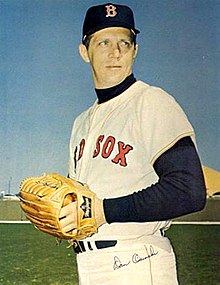
Daniel Osinski (November 17, 1933 – September 13, 2013), nicknamed "The Silencer", was an American Major League Baseball relief pitcher. The 6 ft 2 in (1.88 m), 195 pounds (88 kg) right-hander was signed by the Cleveland Indians as an amateur free agent before the 1952 season. He played for the Kansas City Athletics (1962), Los Angeles Angels (1962–1964), Milwaukee Braves (1965), Boston Red Sox (1966–1967), Chicago White Sox (1969), and Houston Astros (1970).
Born in Chicago, Osinski played baseball, football, and basketball in high school. He almost attended the United States Naval Academy on a football scholarship, but after flunking his physical, he chose instead to sign a contract with the Indians. He played minor league baseball with them for a few years but was plagued by mononucleosis, which he was diagnosed with in 1955. In 1957, Osinski was drafted by the United States Army, serving at Fort Campbell for two years. Unsure whether he should continue playing baseball or not, Osinski tried out with the White Sox in 1959 and was added to one of their minor league clubs. He focused on serving as a relief pitcher and made his major league debut with the Athletics in 1962. Though he did not last long with the Athletics, Osinski impressed the Angels' general manager while pitching for the minor league Portland Beavers. The Angels acquired him in a trade, and he helped give the team one of the best bullpens in the major leagues in 1962. In 1963, he made 16 starts for the club, though he also appeared in 31 games in relief. He posted a 3.48 earned run average (ERA) used mainly in relief in 1964, then was traded to Milwaukee. (Full article...) -
Image 15Raymond Harvey (3 January 1926 – 6 January 2011) was an Australian former first-class cricketer who played for Victoria in the 1940s and 1950s. He was the brother of Australian Test batsmen Merv and Neil and first-class cricketer and umpire Mick Harvey. Ray Harvey was an attacking and talented batsman but failed to reach international standards and only managed to hold down a regular position in the Victorian team in two seasons in the 1950s. This failure to match the standards set by his Test-capped brothers was often attributed to a lack of single-mindedness and hunger.
Harvey was born into a working-class, devoutly Methodist family. His father was a keen amateur cricketer and an instilled a love of the game in his six sons, all of whom played for Fitzroy in Victorian Premier Cricket. Harvey made his first class debut in the middle of the 1947–48 season, and played his first two matches for Victoria alongside his more decorated brothers Merv and Neil. However, he performed poorly and did not play a match in the following summer and for the two subsequent seasons, he played in only three games but contributed little to his team's cause. In 1951–52 he made five appearances, gaining selection only when Victoria's Test players were busy representing Australia. The following season, he gained selection for the last three matches and broke through for his maiden first-class century, having never previously passed 50. (Full article...)
Did you know (auto-generated) - load new batch

- ... that Helene Hathaway Britton, the first woman to own a Major League Baseball team, was unsuccessfully pressured by other club owners to sell the team?
- ... that baseball player Shane Rawley has published a novel?
- ... that Major League Baseball pitcher Charlie Gray was billed as his team's pitcher "of six fingers and six toed fame" and called "a freak" by the Sporting Life?
- ... that labor lawyer Dick Moss argued the 1975 case which resulted in the establishment of free agency in Major League Baseball?
- ... that the six highest Minor League Baseball season attendance counts were all at Sahlen Field?
- ... that Puerto Rico's Willie Hernández became the highest paid player in Detroit Tigers history after winning Cy Young and Most Valuable Player awards and a World Series?
- ... that the ownership group of San Diego's MLS team includes a Native American tribe and baseball player Manny Machado?
- ... that Zack Kelly received a $500 signing bonus, lost money in his first professional seasons, and was released by two organizations before he made his Major League Baseball debut?
Quotes
| It breaks your heart. It is designed to break your heart. The game begins in the spring, when everything else begins again, and it blossoms in the summer, filling the afternoons and evenings, and then as soon as the chill rains come, it stops and leaves you to face the fall alone. |
 Featured lists - load new batch
Featured lists - load new batch
-
Image 1

Tim Dillard is the Sounds' career leader in wins (48), games pitched (242), innings pitched (710), and strikeouts (437).
The Nashville Sounds Minor League Baseball team has played in Nashville, Tennessee, since being established in 1978 as an expansion team of the Double-A Southern League. They moved up to Triple-A in 1985 as members of the American Association before joining the Pacific Coast League in 1998. The team was placed in the Triple-A East in 2021 prior to this becoming the International League in 2022. In the history of the franchise, numerous players and teams have set records in various statistical areas during single games, entire seasons, or their Sounds careers.
Of the nine Sounds who hold the 19 career records tracked by the team, Tim Dillard holds the most, with seven. He is followed by Skeeter Barnes and Chad Hermansen, with three each; and Keith Brown, Mark Corey, Hugh Kemp, Otis Nixon, Tike Redman, and Joey Wendle, with one apiece. Dillard holds the most franchise records, with eight. He is followed by Jamie Werly, with six; and Steve Balboni and Skeeter Barnes, who hold four records each. (Full article...) -
Image 2

Ken Griffey Jr. was the first pick overall in the 1987 draft, a 13-time All-Star selection during his career, and a first-ballot Hall of Fame inductee in 2016.
The Seattle Mariners are a Major League Baseball (MLB) franchise based in Seattle, Washington. They play in the American League West division. Since the franchise entered the league as an expansion team in 1977, they have selected 47 players in the first round. Officially known as the "First-Year Player Draft", the Rule 4 Draft is Major League Baseball's primary mechanism for assigning amateur baseball players from high schools, colleges, and other amateur baseball clubs to its teams. The draft order is determined based on the previous season's standings, with the team possessing the worst record receiving the first pick. In addition, teams that lost free agents in the previous off-season may be awarded compensatory or supplementary picks. The First-Year Player Draft is unrelated to the 1976 expansion draft through which the Mariners filled their roster.
Of the 47 players selected in the first round by the Mariners, 18 have been pitchers, the most of any position; of whom 13 were right-handed and five left-handed. They have also drafted nine outfielders, eight shortstops, seven catchers, three first basemen and two third baseman. Seattle has never drafted a second baseman in the first round. The Mariners have drafted 22 players out of high school, and 24 out of college. All of the college selections came from four-year institutions; the team has never selected a junior college player in the first round. The Mariners have drafted 11 players from high schools or colleges in California, four players from Florida, and a single player from their home state of Washington. One of the Mariners' 2007 picks—Canadian Phillippe Aumont—is the only selection from outside the United States. (Full article...) -
Image 3
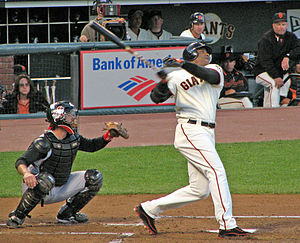
Barry Bonds, the all-time career home run leader in Major League Baseball, led the league in home runs twice including in 2001 when he set the record single-season mark
In baseball, a home run is scored when the ball is hit so far that the batter is able to circle all the bases ending at home plate, scoring himself plus any runners already on base, with no errors by the defensive team on the play. An automatic home run is achieved by hitting the ball on the fly over the outfield fence in fair territory. More rarely, an inside-the-park home run occurs when the hitter reaches home plate while the baseball remains in play on the field. In Major League Baseball (MLB), a player in each league[L] wins the home run title each season by hitting the most home runs that year. Only home runs hit in a particular league count towards that league's seasonal lead. Mark McGwire, for example, hit 58 home runs in 1997, more than any other player that year. However, McGwire was traded from the American League's (AL) Oakland Athletics to the National League's (NL) St. Louis Cardinals midway through the season and his individual AL and NL home run totals (34 and 24, respectively) did not qualify to lead either league.
The first home run champion in the National League was George Hall. In the league's inaugural 1876 season, Hall hit five home runs for the short-lived National League Philadelphia Athletics. In 1901, the American League was established and Hall of Fame second baseman Nap Lajoie led it with 14 home runs for the American League Philadelphia Athletics. Over the course of his 22-season career, Babe Ruth led the American League in home runs twelve times. Mike Schmidt and Ralph Kiner have the second and third most home run titles respectively, Schmidt with eight and Kiner with seven, all won in the National League. Kiner's seven consecutive titles from 1946 to 1952 are also the most consecutive home run titles by any player. (Full article...) -
Image 4

Nolan Ryan is Major League Baseball's all-time strikeout leader at 5,714.
In Major League Baseball (MLB), the 3,000 strikeout club is the group of 19 pitchers who have struck out 3,000 or more batters in their careers. Walter Johnson became the first member in 1923, and was the only one until Bob Gibson joined in 1974. The most recent addition is Max Scherzer, who joined on September 12, 2021. The group includes three left-handed pitchers: CC Sabathia, Steve Carlton, and Randy Johnson. Randy Johnson reached the mark with the fewest games pitched and innings pitched. The Minnesota Twins were the first of four franchises to see multiple pitchers record their 3,000th strikeout: Walter Johnson (while the franchise was called the Washington Senators) in 1923 and Bert Blyleven in 1986. The other teams with multiple members are the Chicago Cubs (Ferguson Jenkins and Greg Maddux), the New York Yankees (Phil Niekro and Sabathia), and the Houston Astros (Nolan Ryan and Justin Verlander). César Gerónimo is the only player struck out by two pitchers for their 3,000th strikeout: Gibson in 1974 and Ryan in 1980. Ten 3,000-strikeout pitchers are also members of the 300-win club. Seven members were named to the All-Century Team, a list of MLB's best 100 players; fans later elected four of them as starters. Thirteen members of the club also won a Cy Young Award in their careers.
The club is considered to almost be a guarantee of entry into the National Baseball Hall of Fame. Fourteen members of the 3,000-strikeout club have been elected to the Hall, most recently Randy Johnson, Pedro Martínez, and John Smoltz, all voted in during the 2015 balloting. Three more members - Sabathia, Scherzer, and Verlander - are not yet eligible for election, being neither dead for six months nor retired for five seasons. The remaining two, Roger Clemens and Curt Schilling, made their first appearances on the ballot for the 2013 elections and received about half of the total votes needed for induction before falling off the ballot in 2022. Clemens' future election is seen as uncertain because of his alleged links to use of performance-enhancing drugs. (Full article...) -
Image 5

Frank Bancroft managed the Worcester team in 1879 and 1880.
The Worcester Worcesters, sometimes referred to as the Brown Stockings or the Ruby Legs, were a Major League Baseball team based in Worcester, Massachusetts. Though the team's alternate names appear in many modern sources, no contemporary records from the time exist that support the use of names other than "Worcester". They existed in the National League (NL) from 1880 to 1882, and played their home games at the Worcester Agricultural Fairgrounds.
The team was organized in 1879 as the Worcester Baseball Association, and joined the minor league National Association. The team was profitable, successful against rival teams, and did well against NL teams in exhibition games. After the season, team management turned their attention on the NL, and pursued the slot vacated by the departing Syracuse Stars. The team was voted into the NL by a majority of the owners, and in 1880, the team began their first season. The manager of the team, Frank Bancroft, and many of the players stayed with the team when it joined the NL, including pitchers Lee Richmond and Tricky Nichols, and position players Arthur Irwin, Doc Bushong, Charlie Bennett, and Chub Sullivan. On June 12, Richmond threw the first perfect game in major league history, against the Cleveland Blues. Harry Stovey, in his first major league season, led the league in triples and home runs. However, the Ruby Legs were, in turn, no-hit on August 20 by Pud Galvin of the Buffalo Bisons, becoming the first team to be no-hit at home. They played 85 games in their first season, and had a win–loss record of 40 wins, 43 losses, with 2 ties, finishing fifth in the league. (Full article...) -
Image 6

The Philadelphia Phillies won their second consecutive pennant in 2009 and lost to the San Francisco Giants in the 2010 NLCS.
The National League pennant winner of a given Major League Baseball season is the team that wins the championship—the pennant—of MLB's National League (NL). This team receives the Warren C. Giles Trophy and the right to play in the World Series against the champion of the American League (AL). The current NL pennant winners are the Los Angeles Dodgers, who beat out the New York Mets to win the NL pennant in October 2024.
The trophy is named for Warren Giles, the league president from 1951 to 1969, and is presented immediately after each NL Championship Series (NLCS) by Warren's son Bill Giles, the honorary league president and former owner of the Philadelphia Phillies. (Full article...) -
Image 7

Ted Williams has the highest career on-base percentage in MLB history, led the American League in 12 seasons (also a record), and held the single-season on-base percentage record for 61 years.
In baseball statistics, on-base percentage (OBP) is a measure of how often a batter reaches base for any reason other than a fielding error, fielder's choice, dropped or uncaught third strike, fielder's obstruction, or catcher's interference. OBP is calculated in Major League Baseball (MLB) by dividing the sum of hits, walks, and times hit by a pitch by the sum of at-bats, walks, times hit by pitch and sacrifice flies. A hitter with a .400 on-base percentage is considered to be great and rare; only 61 players in MLB history with at least 3,000 career plate appearances (PA) have maintained such an OBP. Left fielder Ted Williams, who played 19 seasons for the Boston Red Sox, has the highest career on-base percentage, .4817, in MLB history. Williams led the American League (AL) in on-base percentage in twelve seasons, the most such seasons for any player in the major leagues. Barry Bonds led the National League (NL) in ten seasons, a NL record. Williams also posted the then-highest single-season on-base percentage of .5528 in 1941, a record that stood for 61 years until Bonds broke it with a .5817 OBP in 2002. Bonds broke his own record in 2004, setting the current single-season mark of .6094.
Players are eligible for the Hall of Fame if they have played at least 10 major league seasons, have been either retired for five seasons or deceased for six months, and have not been banned from MLB. These requirements leave 6 living players ineligible who have played in the past 5 seasons; 5 players (Bill Joyce, Ferris Fain, Jake Stenzel, Bill Lange, and George Selkirk) who did not play 10 seasons in MLB; and Shoeless Joe Jackson, who was banned for his role in the Black Sox Scandal.
Josh Gibson had a career obp of .458 but inexplicably isn’t on the list. (Full article...) -
Image 8
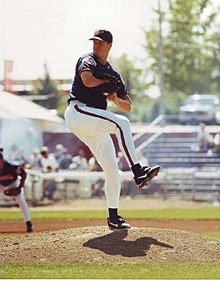
Jim Abbott (1988), born without a right hand, won the 1987 Golden Spikes Award, the 1992 Tony Conigliaro Award, and the 1995 Hutch Award.
The Los Angeles Angels are a Major League Baseball (MLB) franchise based in Anaheim, California. They play in the American League (AL) West division. Since the institution of Major League Baseball's Rule 4 Draft in 1965, the Angels have selected 62 players in the first round. Officially known as the "First-Year Player Draft", the Rule 4 Draft is Major League Baseball's primary mechanism for assigning amateur players from high schools, colleges, and other amateur clubs to its teams. The draft order is determined based on the previous season's standings, with the team possessing the worst record receiving the first pick. In addition, teams which lost free agents in the previous off-season may be awarded compensatory or supplementary picks.
Of the 66 players drafted by the Angels, 29 have been pitchers, the most of any position; 18 of these were right-handed, while 11 were left-handed. Fourteen outfielders, eight shortstops, four third basemen, and four first basemen were also taken. No second basemen have been selected. Thirteen of the players came from high schools or universities in the state of California, while Florida follows with six players. Four players have been selected from both Illinois and Georgia. All players selected have been from the United States. The franchise has made five selections in the same draft three times, in 1986, 2009, and 2010. (Full article...) -
Image 9

The Nashville Sounds ownership group consisted of 15 shareholders in their inaugural 1978 season. (Top row, from left: Bob Elliott, Billy Griggs, Jimmy Miller, Walter Nipper, Farrell Owens; Middle row: Jerry Reed, Larry Schmittou, Cal Smith, Gene Smith, Marcella Smith; Bottom row: Reese Smith Jr., Reese Smith III, Steven Smith, Conway Twitty, and L. E. White)
The Nashville Sounds Minor League Baseball team has played in Nashville, Tennessee, since being established in 1978 as an expansion team of the Double-A Southern League. They moved up to Triple-A in 1985 as members of the American Association before joining the Pacific Coast League in 1998. They were placed in the Triple-A East in 2021, but this became the International League in 2022. The Sounds were originally owned by a local group, headed by Larry Schmittou, which included baseball figures, country musicians, and businessmen. Shares in the team have subsequently changed hands multiple times. Since 2009, the Sounds have been owned by MFP Baseball, composed of real estate investors Masahiro Honzawa and Frank Ward.
In the franchise's history, 15 general managers (GMs) have been employed to oversee day-to-day operations. Among the responsibilities of the general manager are overseeing ticket and advertising sales, developing corporate relationships, managing front office and game-day staff, and maintaining the team's player development license with their Major League Baseball affiliate. The longest-tenured general manager is Larry Schmittou with 13 years of service to the team in that role from 1980 to 1982 and 1987 to 1996. Adam English has been the Sounds' GM since October 2021. (Full article...) -
Image 10

David Ortiz has won the most Silver Slugger Awards as a designated hitter, with seven.
The Silver Slugger Award is awarded annually to the best offensive player at each position in both the American League (AL) and the National League (NL), as determined by the coaches and managers of Major League Baseball (MLB). These voters consider several offensive categories in selecting the winners, including batting average, slugging percentage, and on-base percentage, in addition to "coaches' and managers' general impressions of a player's overall offensive value". Managers and coaches are not permitted to vote for players on their own team. The Silver Slugger was first awarded in 1980 and is given by Hillerich & Bradsby, the manufacturer of Louisville Slugger bats. The award is a bat-shaped trophy, 3 feet (91 cm) tall, engraved with the names of each of the winners from the league and plated with sterling silver.
From 1980 to 2019, and in 2021, a Silver Slugger Award for designated hitters (DH) was only given in the American League, because use of a DH in place of the pitcher in the batting order was prohibited in the National League; a Silver Slugger Award for pitchers was given for the National League instead. In the 2020 season, the National League temporarily allowed use of the designated hitter, and no pitcher was awarded the Silver Slugger Award. An award was given instead to the best designated hitter in the National League. The first NL Silver Slugger Award for designated hitter was given to Marcell Ozuna. Beginning in 2022, the pitcher Silver Slugger Award was retired after MLB announced the full-time implementation of the universal DH rule in both leagues. The Silver Slugger Award for DH is now awarded in both leagues. (Full article...) -
Image 11
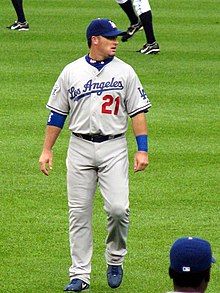
Mark Sweeney, the career pinch hit RBI recordholder, was named to the All-America Team in 1991 by both the American Baseball Coaches Association and Collegiate Baseball.
An All-American team is an honorary sports team composed of the best amateur players of a specific season for each position—who in turn are given the honorific "All-America" and typically referred to as "All-American athletes", or simply "All-Americans". Although the honorees generally do not compete as a unit, the term is used in U.S. team sports to refer to players who are selected by members of the national media. Walter Camp selected the first All-America team in the early days of American football in 1889. In 1950, the American Baseball Coaches Association (ABCA) selected its first All-American baseball team. It has since chosen All-American teams and a player of the year for each division (National Collegiate Athletic Association (NCAA) Division I, Division II, Division III, National Association of Intercollegiate Athletics, junior college and high school). In 1991, Collegiate Baseball began selecting college All-American, Freshman All-American, and High School All-American teams. Baseball America has selected – since 1981 – pre-season and post-season All-American teams and College Player of the Year honorees.
Various organizations selected All-American lists of the best players for the 1991 NCAA Division I college baseball season. The ABCA, the magazine Baseball America, and Collegiate Baseball were the NCAA-sanctioned selectors. This list only includes players selected to the post-season All-American first team for each selector. However, many All-American selections choose second, third, etc. teams from the remaining eligible candidates. (Full article...) -
Image 12The Pittsburgh Pirates are a Major League Baseball (MLB) franchise based in Pittsburgh, Pennsylvania. They play in the National League Central division. Since the establishment of the Rule 4 Draft the Pirates have selected 72 players in the first round. Officially known as the "First-Year Player Draft", the Rule 4 Draft is MLB's primary mechanism for assigning players from high schools, colleges, and other amateur clubs to its franchises. The draft order is determined based on the previous season's standings, with the team possessing the worst record receiving the first pick. In addition, teams which lost free agents in the previous off-season may be awarded compensatory or supplementary picks.
Of these 72 players, 27 have been pitchers, the most of any position; 20 of these were right-handed, while 7 were left-handed. 17 outfielders and 15 shortstops were selected. The Pirates have also drafted 7 catchers, 3 first basemen, and 3 third basemen, but have never selected a second baseman in the first round. Eleven players came from high schools or universities in the state of California, while eight came from Florida. (Full article...) -
Image 13

Greg Maddux has won 18 Gold Gloves, the most in Major League Baseball history.
The Gold Glove Award is the award given annually to the Major League Baseball players judged to have exhibited superior individual fielding performances at each fielding position in both the National League (NL) and the American League (AL), as voted by the managers and coaches in each league. Managers are not permitted to vote for their own players. Eighteen Gold Gloves are awarded each year (with the exception of 1957, 1985, 2007 and 2018), one at each of the nine positions in each league. In 1957, the baseball glove manufacturer Rawlings created the Gold Glove Award to commemorate the best fielding performance at each position. The award was created from a glove made from gold lamé-tanned leather and affixed to a walnut base. Initially, only one Gold Glove per position was awarded to the top fielder at each position in the entire league; however, separate awards were given for the National and American Leagues beginning in 1958.
Greg Maddux has won the most Gold Glove Awards among all players, including pitchers, in Major League Baseball history. He won 18 awards, all in the National League; his streak of wins was consecutive from 1990 through 2002 until interrupted by Mike Hampton in 2003. Maddux won five more awards from 2004 to 2008, after which he retired. Jim Kaat is second and held the record for most wins (16) until he was displaced by Maddux in 2007. He won 14 awards in the American League and 2 in the National League; his 16 consecutive awards is a record among winners. Bob Gibson won nine Gold Gloves with the St. Louis Cardinals, and the inaugural winner Bobby Shantz won four awards in each league, for a total of eight. Mark Langston and Mike Mussina are tied for the fifth-highest total, with seven wins each. Zack Greinke currently ranks seventh with six wins. Gold Glove winners at pitcher who have been inducted into the Baseball Hall of Fame include Gibson, Kaat, Mussina, Maddux, Steve Carlton, Jim Palmer, and Phil Niekro. (Full article...) -
Image 14In its 123-year history, the Baltimore Orioles baseball franchise of Major League Baseball's American League has employed 42 managers. The duties of the team manager include team strategy and leadership on and off the field. Of those 42 managers, 12 have been "player-managers"; specifically, they managed the team while still being signed as a player. Since 1992, the team has played its home games at Oriole Park at Camden Yards.
The Baltimore franchise began operations in Milwaukee, Wisconsin, as the Brewers (not to be confused with the current National League team of the same name) in 1901. After one season in Wisconsin under manager and Hall of Famer Hugh Duffy, the franchise moved south to St. Louis, Missouri, adopting the St. Louis Browns name and hiring a new manager, Jimmy McAleer. The Browns remained in Missouri until the end of the 1953 season, when Major League Baseball's owners elected to move the franchise to Baltimore, Maryland, where they were renamed the Orioles, after Maryland's state bird. (Full article...) -
Image 15
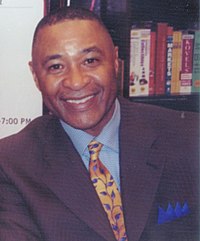
Ozzie Smith has won 13 Gold Glove Awards at shortstop, tying him for the third-highest total among winners at all positions.
The Rawlings Gold Glove Award, usually referred to as the Gold Glove, is the award given annually to the Major League Baseball players judged to have exhibited superior individual fielding performances at each fielding position in both the National League (NL) and the American League (AL), as voted by the managers and coaches in each league. Managers are not permitted to vote for their own players. Eighteen Gold Gloves are awarded each year (with the exception of 1957, 1985, 2007, and 2018), one at each of the nine positions in each league. In 1957, the baseball glove manufacturer Rawlings created the Gold Glove Award to commemorate the best fielding performance at each position. The award was created from a glove made from gold lamé-tanned leather and affixed to a walnut base. Initially, only one Gold Glove per position was awarded to the top fielder at each position in the entire league; however, separate awards were given for the National and American Leagues beginning in 1958.
Ozzie Smith, known as "the Wizard of Oz", has won the most Gold Glove Awards at shortstop; he captured 13 awards in his 19 seasons with the St. Louis Cardinals. Omar Vizquel is second among shortstops with 11 wins; he won two with the San Francisco Giants in the National League after winning nine with the Seattle Mariners and the Cleveland Indians in the American League. Luis Aparicio won nine times at shortstop for the third-highest total, followed by Mark Belanger with eight wins. Dave Concepción and Derek Jeter have won five awards; four-time winners at shortstop include Brandon Crawford, Tony Fernández, Jimmy Rollins, Andrelton Simmons and Alan Trammell. Hall of Famers who have won Gold Glove Awards at shortstop include Smith, Aparicio, Trammell, Ernie Banks, Robin Yount, Barry Larkin and Cal Ripken Jr., whose 2,632 consecutive games played earned him his "Iron Man" nickname. (Full article...)
More did you know
- ... that Baseball Hall of Fame executive Ed Barrow discovered Honus Wagner, converted Babe Ruth into an outfielder, and pioneered the first uniform numbers?
- ... that Matt Cain threw more pitches in his perfect game than any other perfect game pitcher before him?
- ... that Chris Archer pitched USA Baseball's International Performance of the Year in 2010?
- ... that Ross Youngs is the member of the National Baseball Hall of Fame who died at the youngest age?
- ... that Cotton Tierney's great-great-nephew named a website after him that has received over 4 million page views?
Sports portals
Selected picture
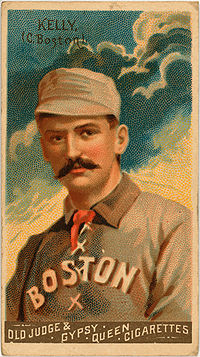
| Credit: Benjamin K. Edwards Collection |
Michael Joseph "King" Kelly (December 31, 1857 – November 8, 1894) was an American right fielder, catcher, and manager in various professional American baseball leagues including the National League, International Association, Players' League, and the American Association.
Associated Wikimedia
The following Wikimedia Foundation sister projects provide more on this subject:
-
Commons
Free media repository -
Wikibooks
Free textbooks and manuals -
Wikidata
Free knowledge base -
Wikinews
Free-content news -
Wikiquote
Collection of quotations -
Wikisource
Free-content library -
Wikiversity
Free learning tools -
Wiktionary
Dictionary and thesaurus
More portals
- Portals with triaged subpages from June 2018
- All portals with triaged subpages
- Portals with no named maintainer
- Automated article-slideshow portals with 51–100 articles in article list
- Automated article-slideshow portals with 501–1000 articles in article list
- Random portal component with 41–50 available subpages
- Automated article-slideshow portals with 201–500 articles in article list
- Random portal component with 11–15 available subpages
- Random portal component with 21–25 available image subpages







